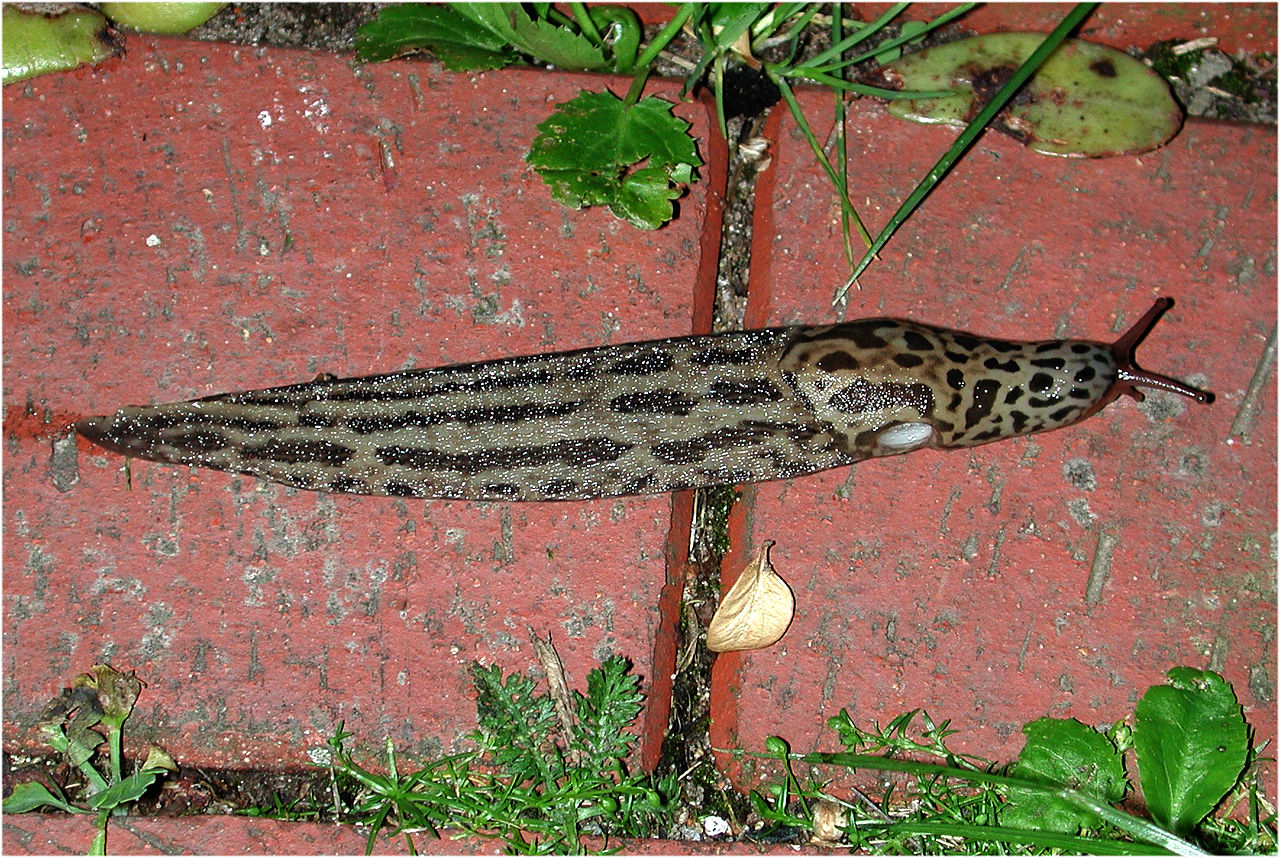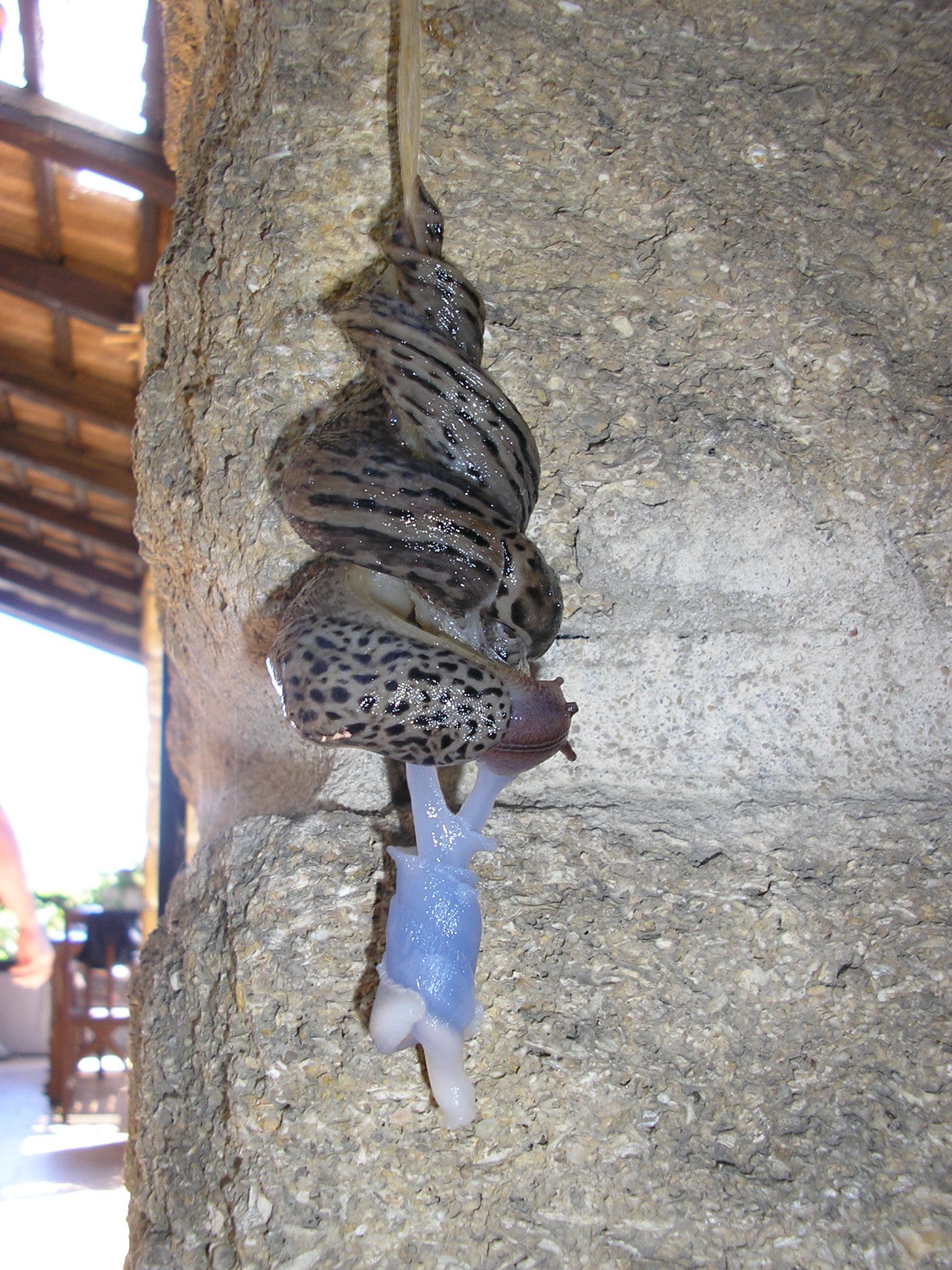Limax maximus
Leopard Slug
Synonyms: Limax cinereus, Limacella parma, Limax antiquorum, Limax maculatas, Limax cellarius
Class: Gastropoda
Order: Stylommatophora
Family: Limacidae


Photographer: G.-U. Tolkiehn Photographer: Grazou903
Source: http://commons.wikimedia.org/wiki/Limax_maximus
Description
Limax maximus is a large (6 in. to more than 8 in.), nocturnal and terrestrial slug in the Limacidae family or the keel back slugs. In the leopard slug the keel is well-marked present towards the posterior end of the body. Another feature of Limacid slugs is the respiratory hole being present in the back-half of the mantle shield. The tentacles are a light to dark brown and it has brown mottling and sometimes lateral bands are present on the posterior end of the body. However, the lateral bands are never on the mantle or head of the snail like a similar species, Lehmannia valentiana.
Ecological Threat: This gastropod eats fresh and rotting plants, more specifically tubers, fruits, and leaves, roots, bulb flowers, ornamental plants, and perennial herbs. Sometimes even carrion of animals. Studies have shown that in Hawaii, temperate slug species like L. maximus negatively affect native plant seedling survivorship creating problems in garden and commercial planting. With a voracious appetite for almost and living or dead plant these slugs can become quite a pest and has also been observed to displace the native Banana Slug, Ariolimax sp in the Northwestern United States. But what makes them even more dangerous is the fact that they can carry the meningitis-causing nematode Angiostrongylus cantonensis. This rat lungworm nematode can infect humans when the gastropod (snail/slug) intermediate hosts are eaten raw or undercooked.
For more information on Angiostrongylus cantonensis click here
Biology: Contrary to many other slugs, Limax maximus can survive its first year to grow as old as three years. Even though the slugs are hermaphroditic they cannot impregnate themselves so two slugs are required for mating. Both crawl towards an overhanging part of a wall or a tree branch, from where they rope down on a slime thread about 16 in. long. Hanging freely in the air they then mate by extending their penises and entwining them. Doing so, they make a characteristic flower like structure below them, where the spermatophores are exchanged (Pictured on the right). After their artistic act of mating, leopard slugs lay as many as 200 large clear eggs, in which the development of the juveniles can well be observed. Freshly hatched leopard slugs are very tiny and pale white in color and, about after a week, they begin to show the first stripes and bands.
History: It was first discovered in cellars of Philadelphia in 1867 and within a few years sighting had expanded into Rhode Island and New York. In 1896 it was discovered in California and is now present in about 38 of the United States.
U.S. Habitat: These slugs are constricted to living in places where they can have easy access to water since they have poor ability to retain water and easily dry out during the day. They live primarily near human settlement but can be found in wooded areas far away from anthropogenic development.
Distribution
Native Origin: Southern and Western Europe, North Africa and Asia Minor
U.S. Present: AK, AL, AR, CA, CT, DE, GA, HI, IA, IL, IN, KS, KY, MA, MD, ME, MI, MO, MN, MT, NC, NH, NJ, NY, OH, OK, RI, PA, SC, TN, TX, VA, VT, WA, WI, WV
Management
In Britain and Europe, a predatory nematode Phasmarhabditis hermaphroditais being sold as a biological control for Limax maximus but it is not sold in the United States. Also, as with other slug species, absolute eradication is nearly impossible. The best way to manage Limax maximus is by early detection and rapid response along with public education to raise awareness of this slug. Report any sightings to TISI or your local environmental agency. If you try to physically remove the slugs on your own, be sure to wear gloves during physical removal of these slugs in case they are infected with Angiostrongylus cantonensis. Slugs are susceptible to carbamate insecticides and iron phosphate. These pesticides coordinated with baits can achieve more effective results in reducing the slug populations.
Text References
Chase, L. M. (1952): The aerial mating of the great slug. Discovery 13:356–359.
Forsyth, R.G. 2004. Land snails of British Columbia. Royal BC Museum , Victoria, Canada
Getz, L.L. and L.F. Chichester. 1971. Introduced European slugs. The Biologist 53: 118‐127
Meyer, W. M., & Cowie, R. H. (2010). Invasive temperate species are a threat to tropical island biodiversity. Biotropica, 42(6), 732-738.
Rollo, C.D. and W.G. Wellington. 1975. Terrestrial slugs in the vicinity of Vancouver, British Columbia. The Nautilus. 89: 107‐115.
Internet Sources
http://www.fcps.edu/islandcreekes/ecology/leopard_slug.htm
http://eol.org/pages/452590/details
http://www.itis.gov/servlet/SingleRpt/SingleRpt?search_topic=TSN&search_value=77311
http://aknhp.uaa.alaska.edu/wp-content/uploads/2011/01/LeopardSlug.pdf
 Texas Invasive Species Institute
Texas Invasive Species Institute